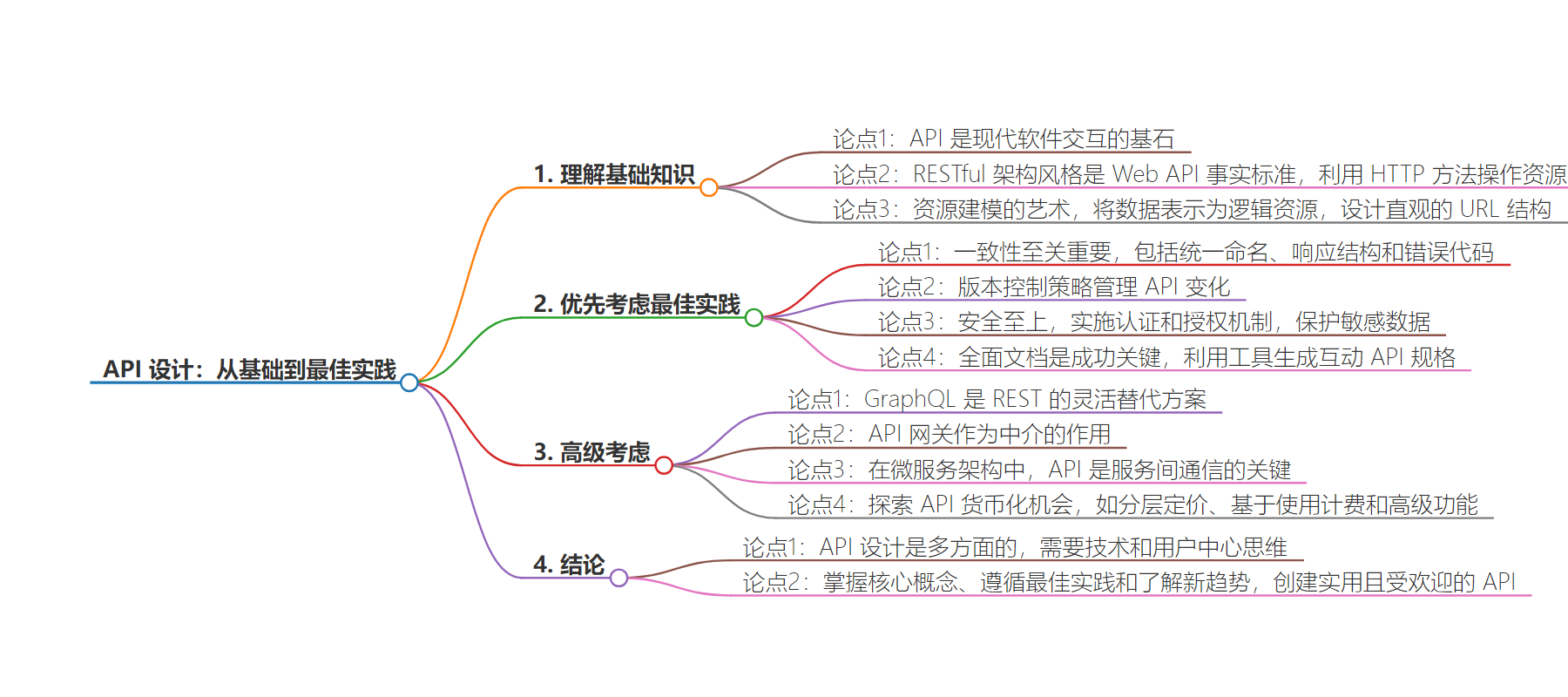包阅导读总结
1.
关键词:API 设计、基本原则、最佳实践、高级概念、总结
2.
总结:本文强调在互联世界中 API 设计的重要性,介绍了其基本原理,包括 RESTful 风格、资源建模等,阐述了遵循最佳实践如一致性、安全性、文档的必要性,还提及了高级考虑如 GraphQL、API 网关、API 货币化等,指出 API 设计需技术与用户思维结合。
3.
主要内容:
– API 设计的重要性
– 是现代软件交互的基石
– 基本原理
– RESTful 是网络 API 事实标准,善用 HTTP 方法
– 资源建模,将数据作为逻辑资源并设计直观的 URL 结构
– 最佳实践
– 保持一致性,包括命名、响应结构和错误码
– 重视安全性,实施认证、授权和数据保护
– 提供全面文档,可用相关工具生成规范
– 高级概念
– GraphQL 提供灵活替代方案
– API 网关的作用
– 微服务架构中 API 是服务间通信关键
– 探索 API 货币化机会
– 结论
– API 设计需技术与用户思维结合,掌握概念和趋势才能创造优质 API
思维导图:
文章地址:https://www.javacodegeeks.com/2024/08/api-design-from-basics-to-best-practices.html
文章来源:javacodegeeks.com
作者:Eleftheria Drosopoulou
发布时间:2024/8/20 12:05
语言:英文
总字数:370字
预计阅读时间:2分钟
评分:87分
标签:API 设计,RESTful API,最佳实践,安全,GraphQL
以下为原文内容
本内容来源于用户推荐转载,旨在分享知识与观点,如有侵权请联系删除 联系邮箱 media@ilingban.com
Crafting exceptional APIs is paramount in today’s interconnected world. This guide delves into the fundamental principles of API design, empowering you to create robust, user-friendly, and scalable interfaces.
Understanding the Fundamentals
A well-crafted API serves as the cornerstone of modern software interactions. At its core, API design revolves around creating a clear and intuitive interface between systems. The RESTful architectural style has emerged as the de facto standard for web APIs, emphasizing the use of HTTP methods to manipulate resources. By understanding the nuances of HTTP verbs like GET, POST, PUT, and DELETE, developers can construct APIs that accurately reflect intended actions.
Equally crucial is the art of resource modeling. Effective API design hinges on representing data as logical resources and designing URL structures that intuitively convey those resources. For instance, a blog platform might expose endpoints like /posts and /comments to represent corresponding data entities.
Prioritizing Best Practices
To create exceptional APIs, adhering to best practices is essential. Consistency is king. Employing uniform naming conventions, response structures, and error codes significantly enhances developer experience. As APIs evolve, strategic versioning becomes indispensable to manage changes without disrupting existing integrations.
Security is paramount. Implementing robust authentication and authorization mechanisms is non-negotiable. Protecting sensitive data with encryption and other safeguards is equally crucial. Comprehensive documentation is another cornerstone of API success. Tools like Swagger and OpenAPI can streamline this process by generating interactive API specifications.
Advanced Considerations
While the fundamentals provide a strong foundation, advanced concepts can elevate API design to new heights. GraphQL offers a flexible alternative to REST, empowering clients to request precise data. API gateways can function as intermediaries, enhancing security, performance, and management. In the realm of microservices architectures, APIs become the lifeblood of communication between services.
Moreover, exploring opportunities for API monetization can unlock additional revenue streams. Whether through tiered pricing models, usage-based billing, or premium features, monetization strategies can add value to your API offering.
Conclusion
API design is a multifaceted discipline that requires a blend of technical expertise and user-centric thinking. By mastering core concepts, adhering to best practices, and staying informed about emerging trends, you can create APIs that are not only functional but also delightful to consume.
